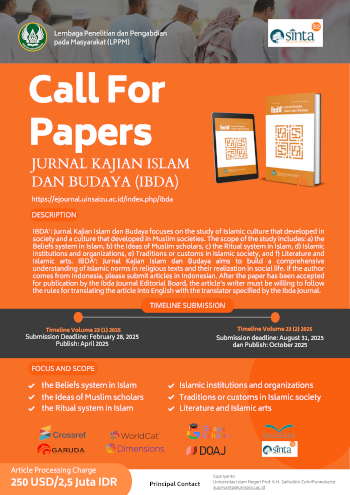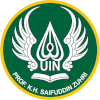Negosiasi Islam dan Budaya Lokal pada Terjemahan Novel “Kisah Seribu Satu Malamâ€: Sebuah Kajian Parateks
DOI:
https://doi.org/10.24090/ibda.v14i1.621Keywords:
sastra populer, parateks, simbol Islam, budaya lokal,Abstract
Alf Laylah wa Laylah novel (tales) translated as “The Arabian Nights†and “Kisah Seribu Satu Malam†is a popular literature in the world. Through the Antoine Galland translation in 1704 entitled Les mille et une nuits, the novel had translated as The Arabian Night and widespread to all over the world. In Indonesia, the Arabian Nights received great reception from the society. One of the empirical evidences from the reception is a Mizan publisher translation which was reached to nineteenth edition. Mizan has translated it by “Kisah Seribu Satu Malam†from the English edition. In 2004, the first volume had nineteen edition, while second has fifteen. These frequences of edition showed the Indonesian people interest to the novel. Through the paratext approach which scrutinizes text from the cover of novel include images, codes, symbols, text and combinated design, this paper argues that translated edition of Kisah Seribu Satu Malam has reflected local readers’ reception considering local culture. Within various covers design, there has been similar message on peaceful and humorous symbol of Indonesian Islam.Downloads
Download data is not yet available.
References
Adi, Ida Rochani. 2010. Sastra Populer: Teori, Metode. Yogyakarta: Pustaka Pelajar.
Anonim. 2004. Kisah Seribu Satu Malam (Jilid I). Penerjemah Rahmani Astuti. Bandung: Mizan.
Anonim. 2004. Kisah Seribu Satu Malam (Jilid II). Penerjemah Rahmani Astuti. Bandung: Mizan.
Aveling, Harry. 2010. “Parateks pada Terjemahan Sapardi Djoko Damono atas Novel Without a Name†dalam Makalah Seminar Internasional “Globalisasi Budaya dan Sastra Indonesiaâ€, Jurusan Sastra Indonesia bekerjasama dengan Program Studi S2 Sastra Fakultas Ilmu Budaya UGM, 3 Nopember 2010.
Damono, Sapardi Djoko. 1999. “Pengaruh Asing dan Terjemahan dalam Sastra Indonesiaâ€, Politik, Ideologi dan Sastra Hibrida. Jakarta: Pustaka Firdaus.
Damono, Sapardi Djoko. 2003. “Kita dan Sastra Duniaâ€, Rublik Pustakaloka, Kompas,. http://www.mifty.tripod.com/id53.html
Genette, Gerard.1997. Paratexts: Thresholds of interpretation (Cambridge: Cambridge University Press.
Makdisi, Saree dan Felicity Nussbaum (ed). 2008. The Arabian nights in Historical Context: Between East and West. New York: Oxford University Press.
Manshur, Fadlil Munawwar. 2011. Perkembangan Sastra Arab dan Teori Sastra Islam. Yogyakarta: Pustaka Pelajar.
Rani, Mohd. Zariat Abdul. 2012. “Islam, Romance and Popular Taste in Indonesia, Indonesia and The Malay World, 40. (2012), h. 116, 59-73.
Rokib, Mohammad. 2015. “Reading Popular Islamic Literature: Continuity and Change in Indonesian Literature,†dalam Journal Heritage of Nusantara, Vol. 4., No., 2, (2015) h. 183-194.
Sahin, Ress. Asst. Ozden. 2014. “Analysis of paratext in The Picture of Dorian Gray in Turkish†dalam Journal of Language and Literature Education, Vol. 11. (2014) h., 54.
Shread, Carolyn. 2010. “Decolonizing Paratexts: Re-Presenting Haitian Literature in English Translation.â€, dalam Neohelicon, 37, (2010) 113-125.
Suharjo, Rias Antho Rahmi. 2012. “Analisis Paratekstual terhadap HikayatWayang Arjuna Karya Muhammad Bakir†dalam Tesis, Jurusan Ilmu Sastra, Universitas Gadjah Mada
Unesco. 2011. Index Translationum. http://databases.unesco.org/xtrans/xTransList.
Watt, Richard. 2005. Packaging Post/Coloniality: The Manufacture of Literary Identity in the Francophone World. Maryland: Lexington Books.
Anonim. 2004. Kisah Seribu Satu Malam (Jilid I). Penerjemah Rahmani Astuti. Bandung: Mizan.
Anonim. 2004. Kisah Seribu Satu Malam (Jilid II). Penerjemah Rahmani Astuti. Bandung: Mizan.
Aveling, Harry. 2010. “Parateks pada Terjemahan Sapardi Djoko Damono atas Novel Without a Name†dalam Makalah Seminar Internasional “Globalisasi Budaya dan Sastra Indonesiaâ€, Jurusan Sastra Indonesia bekerjasama dengan Program Studi S2 Sastra Fakultas Ilmu Budaya UGM, 3 Nopember 2010.
Damono, Sapardi Djoko. 1999. “Pengaruh Asing dan Terjemahan dalam Sastra Indonesiaâ€, Politik, Ideologi dan Sastra Hibrida. Jakarta: Pustaka Firdaus.
Damono, Sapardi Djoko. 2003. “Kita dan Sastra Duniaâ€, Rublik Pustakaloka, Kompas,. http://www.mifty.tripod.com/id53.html
Genette, Gerard.1997. Paratexts: Thresholds of interpretation (Cambridge: Cambridge University Press.
Makdisi, Saree dan Felicity Nussbaum (ed). 2008. The Arabian nights in Historical Context: Between East and West. New York: Oxford University Press.
Manshur, Fadlil Munawwar. 2011. Perkembangan Sastra Arab dan Teori Sastra Islam. Yogyakarta: Pustaka Pelajar.
Rani, Mohd. Zariat Abdul. 2012. “Islam, Romance and Popular Taste in Indonesia, Indonesia and The Malay World, 40. (2012), h. 116, 59-73.
Rokib, Mohammad. 2015. “Reading Popular Islamic Literature: Continuity and Change in Indonesian Literature,†dalam Journal Heritage of Nusantara, Vol. 4., No., 2, (2015) h. 183-194.
Sahin, Ress. Asst. Ozden. 2014. “Analysis of paratext in The Picture of Dorian Gray in Turkish†dalam Journal of Language and Literature Education, Vol. 11. (2014) h., 54.
Shread, Carolyn. 2010. “Decolonizing Paratexts: Re-Presenting Haitian Literature in English Translation.â€, dalam Neohelicon, 37, (2010) 113-125.
Suharjo, Rias Antho Rahmi. 2012. “Analisis Paratekstual terhadap HikayatWayang Arjuna Karya Muhammad Bakir†dalam Tesis, Jurusan Ilmu Sastra, Universitas Gadjah Mada
Unesco. 2011. Index Translationum. http://databases.unesco.org/xtrans/xTransList.
Watt, Richard. 2005. Packaging Post/Coloniality: The Manufacture of Literary Identity in the Francophone World. Maryland: Lexington Books.
Downloads
Published
2016-05-30
How to Cite
rokib, muhammad, & Mudzakkir, M. (2016). Negosiasi Islam dan Budaya Lokal pada Terjemahan Novel “Kisah Seribu Satu Malamâ€: Sebuah Kajian Parateks. IBDA` : Jurnal Kajian Islam Dan Budaya, 14(1), 79–89. https://doi.org/10.24090/ibda.v14i1.621
Issue
Section
Articles
License
Authors who publish with this journal agree to the following terms:
- Authors retain copyright and grant the journal right of first publication with the work simultaneously licensed under a Creative Commons Attribution-ShareAlike License a that allows others to share the work with an acknowledgement of the work's authorship and initial publication in this journal.
- Authors are able to enter into separate, additional contractual arrangements for the non-exclusive distribution of the journal's published version of the work (e.g., post it to an institutional repository or publish it in a book), with an acknowledgment of its initial publication in this journal.
- Authors are permitted and encouraged to post their work online (e.g., in institutional repositories or on their website) before and during the submission process, as it can lead to productive exchanges, as well as earlier and greater citation of published work (See The Effect of Open Access).
















